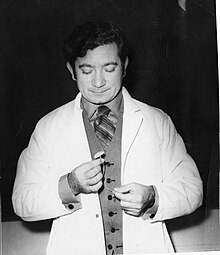| Ommaya reservoir | |
|---|---|
 Schematic of an already-implanted Ommaya reservoir. Schematic of an already-implanted Ommaya reservoir. | |
| Specialty | Neurology |
| [edit on Wikidata] | |


An Ommaya reservoir is an intraventricular catheter system that can be used for the aspiration of cerebrospinal fluid or for the delivery of drugs (e.g. chemotherapy) into the cerebrospinal fluid. It consists of a catheter in one lateral ventricle attached to a reservoir implanted under the scalp. It is used to treat brain tumors, leukemia/lymphoma or leptomeningeal disease by intrathecal drug administration. In the palliative care of terminal cancer, an Ommaya reservoir can be inserted for intracerebroventricular injection (ICV) of morphine.
It was originally invented in 1963 by Ayub K. Ommaya, a Pakistani-American neurosurgeon.
In January 2017, researchers at University of Texas Southwestern Medical Centre used an Ommaya reservoir to measure the intracranial pressure that is regularly observed in astronauts in zero-gravity conditions.
-
 Ommaya reservoir, metal connector pin, and untrimmed peel-away sheath
Ommaya reservoir, metal connector pin, and untrimmed peel-away sheath
-
 Reservoir secured to a trimmed ventricular catheter with silk ties and a marked peel-away introducer sheath
Reservoir secured to a trimmed ventricular catheter with silk ties and a marked peel-away introducer sheath
References
- Leonidas C. Goudas et al.: Acute Decreases in Cerebrospinal Fluid Glutathione Levels after Intracerebroventricular Morphine for Cancer Pain, International Anesthesia Research Society 1999
- "Intracranial pressure could be key to tackling astronaut vision loss". newatlas.com. 2017-01-20. Retrieved 2017-09-21.
- "Under Pressure: Why Spaceflight Is So Hard on Astronauts' Eyes". Space.com. Retrieved 2017-09-21.
- "Why astronauts suffer from vision problems decoded". Deccan Chronicle. 2017-01-18. Retrieved 2017-09-21.
This article related to medical equipment is a stub. You can help Misplaced Pages by expanding it. |